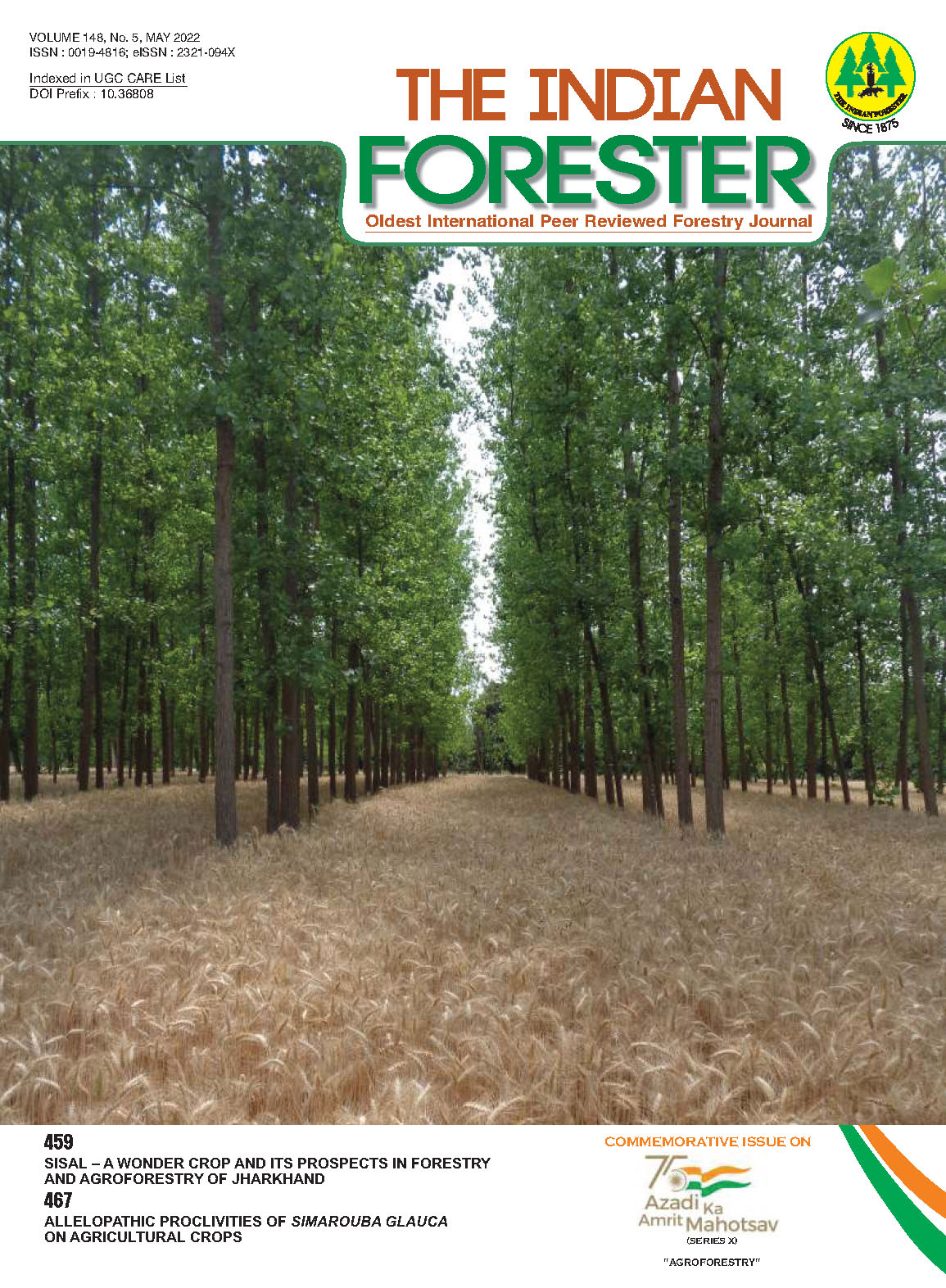Status of Agroforestry contract farming for the paper industry in Jayamkondan block of Ariyalur district, Tamil Nadu
DOI:
https://doi.org/10.36808/if/2022/v148i5/157978Keywords:
Agroforestry contracts, Agribusiness contracts, Paper industry, Dryland areaAbstract
Agroforestry contract farming is on the increase worldwide. Both the state and private industries have been looking to contract with small farmers to grow tree crops in their lands to meet the requirements of increasing demand and the problem of overfelling of forests for wood resources. Various reasons have been cited about small farmers' preferences over large farmers in agroforestry contracts by the companies and multiple factors motivate the participation of small farmers in these contracts. This article reviews the literature on agroforestry contract farming. It uses empirical evidence from Tamil Nadu, India, to identify the various factors influencing small farmers' participation in these contract farming ventures. It also discusses the state's role in promoting and enforcing these contracts. The study's main findings are that per cent of dry land area in the total land is the most significant factor influencing small farmers' participation in agroforestry contract farming.
References
Agarwal C. (2010). Investing cash and kind: An exploratory case study of the investment climate in the Indian forest sector. In Growing green assets: Removing constraints to private sector investment in forestry in Asia and the Pacific Edited (pp. 123-158). FAO.
Chandra J., Chauhan S., Sharma R., Garg R., Singh K. and Saralch H.S. (2011). Development of poplar based agroforestry system. Indian Jounral of Ecology, 11-14.
Current D. and Scherr S.J. (1995). Farmer costs and benefits from agroforestry and farm forestry projects in Central America and the Caribbean: implications for policy. Agroforestry Systems, 30(1-2), 87-103.
Dhinam R.C. (2016). Contractual_arrangements_in_ Agroforestry.pdf. In Agroforestry Present Status and Way Forward (pp. 135-168).
Elias P. and Boucher D. (2014). Planting for the Future. Union of Concerned Scientists.
Laerd. (2018). How to perform a Binomial Logistic Regression in SPSS Statistics | Laerd Statistics. https://statistics.laerd.com/ spss-tutorials/binomial-logistic-regression-using-spssstatistics.php
Lal P. (2011). Clonal agroforestry plantations in India. Indian Ecological Society.
Lasco R.D., Delfino R.J.P. and Espaldon M.L.O. (2014). Agroforestry systems: Helping smallholders adapt to climate risks while mitigating climate change. Wiley Interdisciplinary Reviews: Climate Change, 5(6), 825-833. https://doi.org/10.1002/wcc.301
Misra A. (2010). Agro-Forestry Key for Achieving one third area under Forests and Tree Cover: Punjab Scenario- Replacement of Traditional Crops Wheat-Paddy cycle to Agro-Forestry.
Ong C.K., Black C.R. and Muthuri C.W. (2006). Modifying forestry and agroforestry to increase water productivity in the semi-arid tropics. CAB Reviews: Perspectives in Agriculture, Veterinary Science, Nutrition and Natural Resources.
Osman M. (2018). Agroforestry in Watersheds for Natural Resource Management and Livelihood Security. In Agroforestry Opportunities for Enhancing Resilience to Climate Change in Rainfed Areas.
Pant N. (2011). Motivational Factors in Activities of Agroforestry - A case study. Indian Forester, 363-369.
Parthiban K.T., Sudhagar R.J., Fernandaz C.C. and Krishnakumar N. (2019). Consortium of Industrial Agroforestry: an institutional mechanism for sustaining agroforestry in India. In Current Science Vol. 117, Issue 1).
Parthiban K.T., Vennila S., Kumar P., Saravanan V. and Subbulakshmi V. (2014). Industrial Agroforesty - A Value Chain approach in Tamil Nadu. In Industrial Agroforestry: Perspectives and Prospectives. Scientific Publishers Ind.
Prasad H.D.V. and Singh P. (2012). Contract Farming of Gherkin: Comparative Study of Terms and Conditions. Environment and Ecology, 30(1), 27-29.
Scherr S.J. (2004). Building opportunities for small-farm agroforestry to supply domestic wood markets in developing countries. Agroforestry Systems, 61-62(1-3), 357-370.
Sharma S.K., Arya I., Tewari S., Arya S. and Yadava M. (2018). Clonal plantations play a key role to increase agroforestry production enriching farm communities: Indian experiences. Forestry Research and Engineering: International Journal, 2(6), 306-311.
Spice. (2003). Contract Farming Ventures in India: A Few Successful Cases. Manage: Spice.
Downloads
Downloads
Published
How to Cite
Issue
Section
License
Unless otherwise stated, copyright or similar rights in all materials presented on the site, including graphical images, are owned by Indian Forester.





